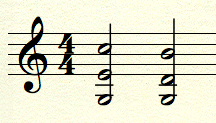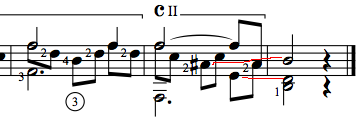Cadential 6/4 Chords
In order to strengthen cadences and give them more motion towards tonic, composer often make use of the Cadential 6/4 chord. In short, it’s the progression I6/4 – V (or V7). I6/4 is the cadential 6/4 chord.
In notation it looks like this:
I would bet that more than a few of you have played just that chord progression!
Labeling
Because roman numeral labels are used both to indicate chord grammar (what the chord is) and chord function (how it moves), labeling a cadential 6/4 chord as I6/4 is a bit of a misnomer. The chord is not a tonic; it is part of the dominant chord. A Cadential 6/4 chord is really a label for suspensions or appogiaturas (non-chord tones that resolve into a chord).
I label cadential 6/4’s like this:
However, many theory teachers will have students label them as I6/4 – V. It doesn’t really matter, but be consistent and use a label that is meaningful to you.
Back to B-minor
The Sor etude in B minor has a wonderful cadential 6/4 chord in the last three measures. We’re in B minor, so our V chord is F#7. Notice that in the first measure of the example the tones are B, D and F#. The bass voice descends an octave, a very common event with cadential 6/4 chords, as the D and B resolve downward to C# and A# respectively. Sor also adds in the E to complete the F#7 chord.
Notice that the A# (leading tone!) resolves up to the B in the final measure and the E (the 7th!) resolves down to D–both events are marked by red lines.
There’s a few other cadential 6/4 chords in this piece. Find them!



